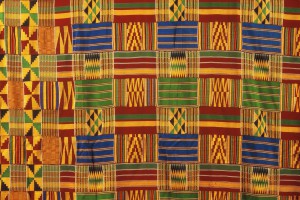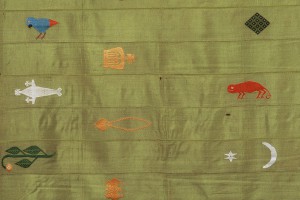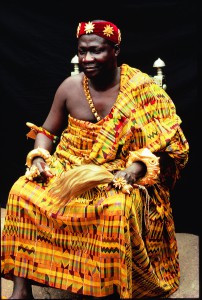The brightly colored, geometrically patterned cloth called kente–made by the Asante (uh SAHN tee) people of Ghana and the Ewe (AY vay) people of Ghana and Togo–is the best known of all African textiles. In African American communities across the nation, kente is much more than mere cloth: it is a symbol of African pride and a powerful cultural icon.

“Wrapped in Pride: Ghanaian Kente and African American Identity,” an exhibition at the California State University, Dominguez Hills University Art Gallery from September 7 to October 18, explores the art of making kente, its symbolism in the cultures of Africa, and its expression of identity in African American communities. Also on display in the University Library will be two concurrent and related exhibitions, “African American Quilters of Los Angeles: A Tradition of Pride” and “African Identities in Textiles and Art.”

The “Wrapped in Pride” exhibit has being made possible through NEH on the Road, a special initiative of the National Endowment for the Humanities. It is brought to you by Mid-America Arts Alliance. This version of “Wrapped in Pride: Ghanaian Kente and African American Identity” was developed by the University of California, Los Angeles Fowler Museum of Cultural History based on an earlier exhibition co-organized with the Newark Museum in Newark, New Jersey.
Kente has its origins in the former Gold Coast of West Africa as festive dress for special occasions. It was traditionally worn by men as a kind of toga and by women as upper and lower wraps. Over the past 40 years, as kente’s popularity blossomed, the cloth has been used in hats, ties, bags, shoes, jewelry, and many other accessories worn on both sides of the Atlantic.

Visitors to “Wrapped in Pride” will begin by exploring kente weaving traditions and seeing extraordinary examples of historic and contemporary kente–including some specifically set out for visitors to touch–and numerous objects incorporating its patterns. The exhibition also considers how kente of the Asante and Ewe cultures came to be used throughout Africa as garments and ceremonial cloth.
Photographs and videos depicting the use of kente in contexts ranging from religious to commercial tell how this traditional art form was transmitted across the ocean, and how it changed as it was embraced around the world as an expression of African cultural identity and pride, worn by the likes of W.E.B. DuBois, Muhammad Ali, Spike Lee, and Nelson Mandela, among others. A final section looks at the prominence of kente during the months of December, January and February, when the confluence of Christmas, Kwanzaa, Martin Luther Kind Jr. Day, and African American History Month prompts its wearing and/or display in a variety of forms, and in church and/or graduation, when it symbolizes heritage, faith, and accomplishment.
The “African American Quilters of Los Angeles: A Tradition of Pride” exhibition in the University Library was organized by quilt curator and African American Quilters of Los Angeles (AAQLA) vice president Estelle Hamilton in conjunction with the University Art Gallery, and will feature 30 brilliantly colored and unique quilts by local quilters relating in theme and design to the kente cloth textiles. AAQLA is celebrating 25 years in 2011. Its members have exhibited their quilts at the City of Carson Civic Center, the California African American Museum in Los Angeles, and California Polytechnic State University, Pomona.
The quilters whose works will be represented are Ree Adams, Anne Bastiste, Olga Chachere, Linda Country, Linda Gardner, Ernestine Hadley, Estelle Hamilton, Lou Holland Jones, Debra Knox, Sharon Mathews, Judith Nash, Emma Quinn, Elvis Smith, Toni Terrell-Randolph, and Audrey Williams.
The exhibition, “African Identities in Textiles and Art,” also in the Library, will showcase objects and textiles collected by the Gamon family during the 1960s and 1970s in West Africa. The exhibit includes an impressive array of textiles, tools, masks and sculptures. Among the objects in the exhibit are Dan masks, Bamana mud cloth, unadorned country cloth, and Dogon statuary. African games, musical instruments, and tools from the collection will offer viewers insight into everyday objects in West Africa.
In conjunction with the three exhibitions there will be a series of special programs in the University Art Gallery:
Wednesday, Sept., 7, 5:30-7:30 p.m.– Opening Celebration with African Dance and Music, featuring the Kente Cloth Ceremony at 6 p.m. led by Peter Abilogu, professor of dance at El Camino College.
Tuesday, Sept. 20, 6 p.m. – African Textiles: The Art of Cultural Identities, a conversation with Dr. Kirstin Ellsworth and Dr. Patricia Gamon, adjunct professors of art history at CSU Dominguez Hills.
Tuesday, Oct. 4, 6 p.m. – African Weaving and African Art History, film and discussion led by Dr. Kirstin Ellsworth, adjunct professor of art history, CSU Dominguez Hills
Tuesday, Oct. 18, 7 p.m. – Kente Cloth in Context and Continuity of the African Diaspora, a discussion with Dr. Munashe Furusa, associate dean of the College of Arts and Humanities and professor of African studies, and Dr. Salim Faraji, professor of Africana studies, CSU Dominguez Hills.
Open on Monday and Wednesday from 10 a.m. to 4 p.m. and Tuesday and Thursday from 11 a.m. to 7 p.m., the University Art Gallery is located in Room A-107 on the first floor of LaCorte Hall on the campus of CSU Dominguez Hills.
University Library hours are Monday through Thursday 8 a.m. to 8 p.m., Friday 8 a.m. to 5 p.m. and Saturday 10 a.m. to 5 p.m.
Admission to all gallery and library events is free. Parking in campus lots costs $4 with passes available for purchase at kiosks located in each lot.
CSU Dominguez Hills is located at 1000 E. Victoria St, Carson, near the junction of the 110, 91 and 405 freeways.
For more information on the exhibitions, contact University Art Gallery director Kathy Zimmerer at kzimmerer@csudh.edu or visit http://cah.csudh.edu/art_gallery.